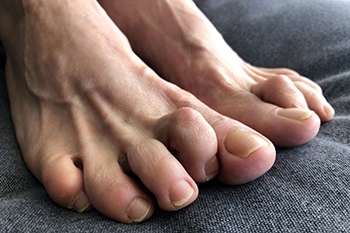
A hammertoe is a toe deformity where the 2nd, 3rd, 4th and/or 5th toe(s) bend downward at the middle joint and look like little hammers. Afflicted toes might also develop corns, calluses, and open sores due to rubbing or irritation from walking or running. Wearing shoes can be painful for those who have hammertoes and inflammation, redness, and/or a burning sensation may be felt in the toe area. Reasons hammertoes develop include wearing shoes that do not fit properly, usually those that push the toes together into a tight toe box. The toes will tighten when repeatedly bent into unnatural positions and lose their ability to stretch out. Sometimes hammertoes can occur from a muscle/tendon imbalance that leaves the toes pointing down due to structural changes in the foot that develop over a long period of time. Less often, a hammertoe results from an earlier injury or congenital defect. With early intervention, hammertoes can often be corrected with minimal treatment. Left untreated, a hammertoe can become permanent, and surgery may be required to reposition it. Treatment includes wearing comfortable, properly fitting shoes with a wide toe box, stretching feet and toes to keep muscles flexible, and wearing pads or orthotics. Further intervention, including surgery might be needed. If you suffer from a hammertoe, see a podiatrist who can properly diagnose the severity of the condition and provide correct treatment options for you.
Hammertoes can be a painful condition to live with. For more information, contact Howard Kimmel, DPM of Buckeye Foot Care. Our doctor will answer any of your foot- and ankle-related questions.
Hammertoe
Hammertoe is a foot deformity that occurs due to an imbalance in the muscles, tendons, or ligaments that normally hold the toe straight. It can be caused by the type of shoes you wear, your foot structure, trauma, and certain disease processes.
Symptoms
- Painful and/or difficult toe movement
- Swelling
- Joint stiffness
- Calluses/Corns
- Physical deformity
Risk Factors
- Age – The risk of hammertoe increases with age
- Sex – Women are more likely to have hammertoe compared to men
- Toe Length – You are more likely to develop hammertoe if your second toe is longer than your big toe
- Certain Diseases – Arthritis and diabetes may make you more likely to develop hammertoe
Treatment
If you have hammertoe, you should change into a more comfortable shoe that provides enough room for your toes. Exercises such as picking up marbles may strengthen and stretch your toe muscles. Nevertheless, it is important to seek assistance from a podiatrist in order to determine the severity of your hammertoe and see which treatment option will work best for you.
If you have any questions, please feel free to contact one of our offices located in Brook Park and Willoughby, OH . We offer the newest diagnostic and treatment technologies for all your foot care needs.
